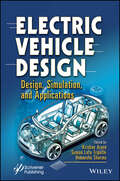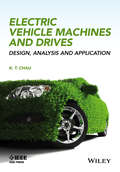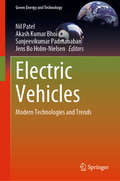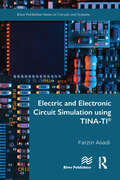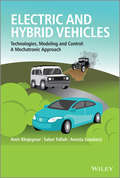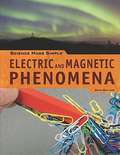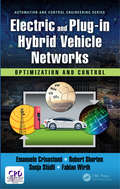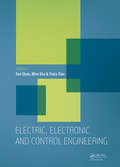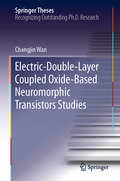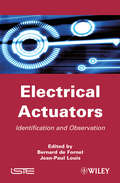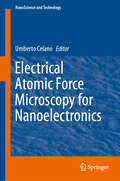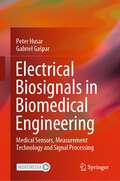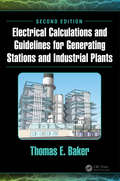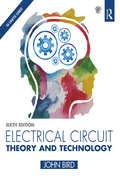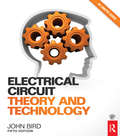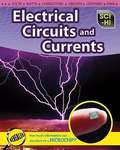- Table View
- List View
Electric Vehicle Design: Design, Simulation, and Applications
by Himanshu Sharma Suman Lata Tripathi Krishan AroraELECTRIC VEHICLE DESIGN This book will serve as a definitive guide to conceptual and practical knowledge about the design of hybrid electrical vehicles (HEV), battery electrical vehicles (BEV), fuel cell electrical vehicles (FCEV), plug-in hybrid electrical vehicles (PHEV), and efficient EV charging techniques with advanced tools and methodologies for students, engineers, and academics alike. This book deals with novel concepts related to fundamentals, design, and applications of conventional automobiles with internal combustion engines (ICEs), electric vehicles (EVs), hybrid electric vehicles (HEVs), and fuel cell vehicles (FCVs). It broadly covers vehicle performance, configuration, control strategy, design methodology, modeling, and simulation for different conventional and hybrid vehicles based on mathematical equations. Fundamental and practical examples of conventional electrical machines, advanced electrical machines, battery energy sources, on-board charging and off-board charging techniques, and optimization methods are presented here. This book can be useful for students, researchers, and practitioners interested in different problems and challenges associated with electric vehicles. Furthermore, in explaining the design methodology of each drive train, design examples are presented with simulation results.
Electric Vehicle Integration in a Smart Microgrid Environment
by Mohammad Saad Alam Mahesh KrishnamurthyElectric Vehicle Integration in a Smart Microgrid Environment The growing demand for energy in today’s world, especially in the Middle East and Southeast Asia, has been met with massive exploitation of fossil fuels, resulting in an increase in environmental pollutants. In order to mitigate the issues arising from conventional internal combustion engine-powered vehicles, there has been a considerable acceleration in the adoption of electric vehicles (EVs). Research has shown that the impact of fossil fuel use in transportation and surging demand in power owing to the growing EV charging infrastructure can potentially be minimalized by smart microgrids. As EVs find wider acceptance with major advancements in high efficiency drivetrain and vehicle design, it has become clear that there is a need for a system-level understanding of energy storage and management in a microgrid environment. Practical issues, such as fleet management, coordinated operation, repurposing of batteries, and environmental impact of recycling and disposal, need to be carefully studied in the context of an ageing grid infrastructure. This book explores such a perspective with contributions from leading experts on planning, analysis, optimization, and management of electrified transportation and the transportation infrastructure. The primary purpose of this book is to capture state-of-the-art development in smart microgrid management with EV integration and their applications. It also aims to identify potential research directions and technologies that will facilitate insight generation in various domains, from smart homes to smart cities, and within industry, business, and consumer applications. We expect the book to serve as a reference for a larger audience, including power system architects, practitioners, developers, new researchers, and graduate-level students, especially for emerging clean energy and transportation electrification sectors in the Middle East and Southeast Asia.
Electric Vehicle Integration into Modern Power Networks
by João A. Peças Lopes Rodrigo Garcia-ValleElectric Vehicle Integration into Modern Power Networks provides coverage of the challenges and opportunities posed by the progressive integration of electric drive vehicles. Starting with a thorough overview of the current electric vehicle and battery state-of-the-art, this work describes dynamic software tools to assess the impacts resulting from the electric vehicles deployment on the steady state and dynamic operation of electricity grids, identifies strategies to mitigate them and the possibility to support simultaneously large-scale integration of renewable energy sources. New business models and control management architectures, as well as the communication infrastructure required to integrate electric vehicles as active demand are presented. Finally, regulatory issues of integrating electric vehicles into modern power systems are addressed. Inspired by two courses held under the EES-UETP umbrella in 2010 and 2011, this contributed volume consists of nine chapters written by leading researchers and professionals from the industry as well as academia.
Electric Vehicle Integration via Smart Charging: Technology, Standards, Implementation, and Applications (Green Energy and Technology)
by Behnam Mohammadi-Ivatloo Vahid VahidinasabThis book brings together important new contributions covering electric vehicle smart charging (EVSC) from a multidisciplinary group of global experts, providing a comprehensive look at EVSC and its role in meeting long-term goals for decarbonization of electricity generation and transportation. This multidisciplinary reference presents practical aspects and approaches to the technology, along with evidence from its applications to real-world energy systems. Electric Vehicle Integration via Smart Charging is suitable for practitioners and industry stakeholders working on EVSC, as well as researchers and developers from different branches of engineering, energy, transportation, economic, and operation research fields.
Electric Vehicle Machines and Drives: Design, Analysis and Application (Wiley - IEEE)
by K. T. ChauA timely comprehensive reference consolidates the research and development of electric vehicle machines and drives for electric and hybrid propulsions• Focuses on electric vehicle machines and drives• Covers the major technologies in the area including fundamental concepts and applications• Emphasis the design criteria, performance analyses and application examples or potentials of various motor drives and machine systems • Accompanying website includes the simulation models and outcomes as supplementary material
Electric Vehicle Propulsion Drives and Charging Systems
by Kundan Kumar Ambrish Devanshu Sanjeet K. DwivediThis book covers the introduction, theory, development, and applications of hybrid and electric vehicles and their charging infrastructures. It also discusses the real applications of power converters and electric drives to give the readers a flavour of how to design propulsion drives and fast charging systems for electric vehicles. It further covers important topics such as static and dynamic wireless charging systems, battery management, and battery swapping systems for electric vehicles.This book: Presents comprehensively different types of electric vehicles and their powertrain architecture. Highlights modern optimization techniques such as genetic algorithms, simulated annealing, particle swarm optimization, and ant colony optimization. Discusses different charging methods such as wired and wireless for a variety of batteries including lead acid, lithium-ion, and vanadium redox. Covers grid-to-vehicle, vehicle-to-grid, and vehicle-to-vehicle bidirectional power flow analysis. Showcases power 2X technologies such as power-to-ammonia, power-to-chemicals, power-to-fuel, power-to-gas, and power-to-hydrogen. The text is primarily written for senior undergraduate and graduate students as well as academic researchers in the fields of electrical engineering, electronics, and communications engineering.
Electric Vehicle Technology Explained
by James Larminie John LowryFully updated throughout, Electric Vehicle Technology, Second Edition, is a complete guide to the principles, design and applications of electric vehicle technology. Including all the latest advances, it presents clear and comprehensive coverage of the major aspects of electric vehicle development and offers an engineering-based evaluation of electric motor scooters, cars, buses and trains.This new edition includes:important new chapters on types of electric vehicles, including pickup and linear motors, overall efficiencies and energy consumption, and power generation, particularly for zero carbon emissionsexpanded chapters updating the latest types of EV, types of batteries, battery technology and other rechargeable devices, fuel cells, hydrogen supply, controllers, EV modeling, ancillary system design, and EV and the environmentbrand new practical examples and case studies illustrating how electric vehicles can be used to substantially reduce carbon emissions and cut down reliance on fossil fuelsfuturistic concept models, electric and high-speed trains and developments in magnetic levitation and linear motorsan examination of EV efficiencies, energy consumption and sustainable power generation.MATLAB® examples can be found on the companion website www.wiley.com/go/electricvehicle2eExplaining the underpinning science and technology, this book is essential for practicing electrical, automotive, power, control and instrumentation engineers working in EV research and development. It is also a valuable reference for academics and students in automotive, mechanical, power and electrical engineering.
Electric Vehicles in Energy Systems: Modelling, Integration, Analysis, and Optimization
by Ali Elkamel Behnam Mohammadi-Ivatloo Ali AhmadianThis book discusses the technical, economic, and environmental aspects of electric vehicles and their impact on electrical grids and energy systems. The book is divided into three parts that include load modeling, integration and optimization, and environmental evaluation. Theoretical background and practical examples accompany each section and the authors include helpful tips and hints in the load modeling and optimization sections. This book is intended to be a useful tool for undergraduate and graduate students, researchers and engineers who are trying to solve power and engineering problems related electric vehicles.Provides optimization techniques and their applications for energy systems;Discusses the economic and environmental perspectives of electric vehicles;Contains the most comprehensive information about electric vehicles in a single source.
Electric Vehicles: Modern Technologies and Trends (Green Energy and Technology)
by Akash Kumar Bhoi Sanjeevikumar Padmanaban Nil Patel Jens Bo Holm-NielsenThis book focuses on the latest emerging technologies in electric vehicles (EV), and their economic and environmental impact. The topics covered include different types of EV such as hybrid electrical vehicle (HEV), battery electrical vehicle (BEV), fuel cell electrical vehicle (FCEV), plug-in hybrid electrical vehicle (PHEV). Theoretical background and practical examples of conventional electrical machines, advanced electrical machines, battery energy sources, on-board charging and off-board charging techniques, and optimization methods are presented here. This book can be useful for students, researchers and practitioners interested in different problems and challenges associated with electric vehicles.
Electric and Electronic Circuit Simulation using TINA-TI®
by Farzin AsadiA circuit simulator is a computer program that permits us to see circuit behavior, i.e. circuit voltages and currents, without making the circuit. Use of a circuit simulator is a cheap, efficient, and safe way to study the behavior of circuits. The Toolkit for Interactive Network Analysis (TINA®) is a powerful yet affordable SPICE based circuit simulation and PCB design software package for analyzing, designing, and real time testing of analog, digital, VHDL, MCU, and mixed electronic circuits and their PCB layouts. This software was created by DesignSoft. TINA-TI is a spinoff software program that was designed by Texas Instruments (TI®) in cooperation with DesignSoft which incorporates a library of pre-made TI components for the user to utilize in their designs. This book shows how a circuit can be analyzed in the TINA-TI® environment. Students of engineering (for instance, electrical, biomedical, mechatronics, and robotics to name a few), engineers who work in the industry, and anyone who wants to learn the art of circuit simulation with TINA-TI can benefit from this book.
Electric and Hybrid Vehicles
by Tom Denton Hayley PellsElectric and hybrid vehicles are now the present, not the future. This straightforward and highly illustrated full-colour textbook is endorsed by the Institute of the Motor Industry (IMI) and introduces the subject for further education and undergraduate students as well as technicians and workshop owners, with sections for drivers who are interested to know more. This new edition contains extensively updated content, especially on batteries, charging and the high-voltage pathway and includes all new case studies and new images, photos and flow charts throughout. It covers the different types of electric vehicle, costs and emissions and the charging infrastructure before moving on to explain how hybrid and electric vehicles work. A chapter on electrical technology introduces learners to subjects such as batteries, control systems and charging, which are then covered in more detail within their own chapters. The book also covers the maintenance and repair procedures of these vehicles, including diagnostics, servicing, repair and first-responder information. The book is particularly suitable for students studying towards IMI Level 1 Award in Hybrid Electric Vehicle Awareness, IMI Level 2 Award in Hybrid Electric Vehicle Operation and Maintenance, IMI Level 3 Award in Hybrid Electric Vehicle Repair and Replacement, IMI Level 4 Award in the Diagnosis, Testing and Repair of Electric/Hybrid Vehicles and Components, IMI accreditation, City & Guilds (C&G) and all other EV/hybrid courses.
Electric and Hybrid Vehicles: Design Fundamentals
by Iqbal HusainA thoroughly revised third edition of this widely praised, bestselling textbook presents a comprehensive systems-level perspective of electric and hybrid vehicles with emphasis on technical aspects, mathematical relationships and basic design guidelines. The emerging technologies of electric vehicles require the dedication of current and future engineers, so the target audience for the book is the young professionals and students in engineering eager to learn about the area. The book is concise and clear, its mathematics are kept to a necessary minimum and it contains a well-balanced set of contents of the complex technology. Engineers of multiple disciplines can either get a broader overview or explore in depth a particular aspect of electric or hybrid vehicles. Additions in the third edition include simulation-based design analysis of electric and hybrid vehicles and their powertrain components, particularly that of traction inverters, electric machines and motor drives. The technology trends to incorporate wide bandgap power electronics and reduced rare-earth permanent magnet electric machines in the powertrain components have been highlighted. Charging stations are a critical component for the electric vehicle infrastructure, and hence, a chapter on vehicle interactions with the power grid has been added. Autonomous driving is another emerging technology, and a chapter is included describing the autonomous driving system architecture and the hardware and software needs for such systems. The platform has been set in this book for system-level simulations to develop models using various softwares used in academia and industry, such as MATLAB®/Simulink, PLECS, PSIM, Motor-CAD and Altair Flux. Examples and simulation results are provided in this edition using these software tools. The third edition is a timely revision and contribution to the field of electric vehicles that has reached recently notable markets in a more and more environmentally sensitive world.
Electric and Hybrid Vehicles: Technologies, Modeling and Control - A Mechatronic Approach (Wiley Desktop Editions Ser.)
by Amir Khajepour Avesta Goodarzi M. Saber FallahAn advanced level introductory book covering fundamental aspects, design and dynamics of electric and hybrid electric vehicles There is significant demand for an understanding of the fundamentals, technologies, and design of electric and hybrid electric vehicles and their components from researchers, engineers, and graduate students. Although there is a good body of work in the literature, there is still a great need for electric and hybrid vehicle teaching materials. Electric and Hybrid Vehicles: Technologies, Modeling and Control – A Mechatronic Approach is based on the authors’ current research in vehicle systems and will include chapters on vehicle propulsion systems, the fundamentals of vehicle dynamics, EV and HEV technologies, chassis systems, steering control systems, and state, parameter and force estimations. The book is highly illustrated, and examples will be given throughout the book based on real applications and challenges in the automotive industry. Designed to help a new generation of engineers needing to master the principles of and further advances in hybrid vehicle technology Includes examples of real applications and challenges in the automotive industry with problems and solutions Takes a mechatronics approach to the study of electric and hybrid electric vehicles, appealing to mechanical and electrical engineering interests Responds to the increase in demand of universities offering courses in newer electric vehicle technologies
Electric and Magnetic Phenomena (Science Made Simple)
by Dean GalianoThis book introduces the discovery that electric and magnetic phenomena are a result of positive and negative charges interacting with each other; researchers were able to isolate the negatively charged electron.
Electric and Plug-in Hybrid Vehicle Networks: Optimization and Control (Automation and Control Engineering)
by Emanuele Crisostomi Robert Shorten Sonja Stüdli Fabian WirthThis book explores the behavior of networks of electric and hybrid vehicles. The topics that are covered include: energy management issues for aggregates of plug-in vehicles; the design of sharing systems to support electro-mobility; context awareness in the operation of electric and hybrid vehicles, and the role that this plays in a Smart City context; and tools to test and design massively large-scale networks of such vehicles. The book also introduces new and interesting control problems that are becoming prevalent in the EV-PHEV's context, as well as identifying some open questions. A particular focus of the book is on the opportunities afforded by networked actuation possibilities in electric and hybrid vehicles, and the role that such actuation may play in air-quality and emissions management.
Electric, Electronic and Control Engineering: Proceedings of the 2015 International Conference on Electric, Electronic and Control Engineering (ICEECE 2015), Phuket Island, Thailand, 5-6 March 2015
by Fun Shao Wise Shu Tracy TianElectric, Electronic and Control Engineering contains the contributions presented at the 2015 International Conference on Electric, Electronic and Control Engineering (ICEECE 2015, Phuket Island, Thailand, 5-6 March 2015). The book is divided into four main topics: - Electric and Electronic Engineering - Mechanic and Control Engineering - Informati
Electric, Hybrid, and Fuel Cell Vehicles (Encyclopedia of Sustainability Science and Technology Series)
by Amgad ElgowainyThis volume of "Encyclopedia of Sustainability Science and Technology, Second Edition," covers the electrification of vehicles, which is key to a sustainable future of transportation in both light-duty and heavy-duty vehicle sectors to address global concerns of climate change, air pollutant emissions, energy efficiency and energy security. Vehicle electrification includes several existing and emerging technologies and powertrain architectures such as conventional hybrid electric vehicles (HEVs), plug-in hybrids with various electric driving range, short- and long-range battery electric vehicles, as well as hydrogen fuel cell electric vehicles (FCEVs). Electrification will be key to connected autonomous vehicles, which are perceived to improve mobility, increase safety, reduce energy consumption and infrastructure costs, improve productivity, decrease traffic congestion and increase customer satisfaction. While electrification of vehicle technologies is relatively mature, technology improvement and economies of scale are needed to compete against incumbent technologies and to realize their benefits in the marketplace. Significant infrastructure development is needed in the case of hydrogen fuel cell vehicles and to a lesser extent for plug-in electric vehicles.Vehicle efficiency improvement is sought through a combination of several approaches, including weight reduction, engine downsizing, increased engine compression ratio with high octane fuels, and the use of compression ignition engines with low octane fuels. Liquid hydrocarbon fuels are needed in applications where high storage energy density is required such as long-haul class-8 combination heavy-duty trucks. Shared mobility is another emerging concept that enables access to transportation services on an as-needed basis. This approach can enhance accessibility to transportation, decrease number of vehicles on the road, reduce energy use and impact on the environment, reduce cost of transportation and the need for parking, and reduce transportation time between origin and destination. In all, the reader will receive a comprehensive introduction to electric vehicles and technology trends, including energy storage, in light-, medium-, and heavy-duty sectors, as well as the infrastructure development that will be required to realize these benefits for society.
Electric-Double-Layer Coupled Oxide-Based Neuromorphic Transistors Studies (Springer Theses)
by Changjin WanThis book focuses on essential synaptic plasticity emulations and neuromorphic computing applications realized with the aid of three-terminal synaptic devices based on ion-coupled oxide-based electric-double-layer (EDL) transistors. To replicate the robust, plastic and fault-tolerant computational power of the human brain, the emulation of essential synaptic plasticity and computation of neurons/synapse by electronic devices are generally considered to be key steps. The book shows that the formation of an EDL at the dielectric/channel interface that slightly lags behind the stimuli can be attributed to the electrostatic coupling between ions and electrons; this mechanism underlies the emulation of short-term synaptic behaviors. Furthermore, it demonstrates that electrochemical doping/dedoping processes in the semiconducting channel by penetrated ions from electrolyte can be utilized for the emulation of long-term synaptic behaviors. Lastly, it applies these synaptic transistors in an artificial visual system to demonstrate the potential for constructing neuromorphic systems. Accordingly, the book offers a unique resource on understanding the brain-machine interface, brain-like chips, artificial cognitive systems, etc.
Electrical Actuators: Applications and Performance
by Jean-Paul Louis Bernard de FornelThis helpful resource covers a large range of information regarding electrical actuators. In particular, robustness, a very problematic issue, is fully explored in a dedicated chapter. The text also deals with he estimate of non-measurable mechanical variables by examining the estimate of load moment, then observation of the positioning of a command without mechanical sensor. Finally, it examines the conditions needed to measure variables and real implementation of numerical algorithms. This is a key working resource for electrical engineers.
Electrical Atomic Force Microscopy for Nanoelectronics (NanoScience and Technology)
by Umberto CelanoThe tremendous impact of electronic devices on our lives is the result of continuous improvements of the billions of nanoelectronic components inside integrated circuits (ICs). However, ultra-scaled semiconductor devices require nanometer control of the many parameters essential for their fabrication. Through the years, this created a strong alliance between microscopy techniques and IC manufacturing. This book reviews the latest progress in IC devices, with emphasis on the impact of electrical atomic force microscopy (AFM) techniques for their development. The operation principles of many techniques are introduced, and the associated metrology challenges described. Blending the expertise of industrial specialists and academic researchers, the chapters are dedicated to various AFM methods and their impact on the development of emerging nanoelectronic devices. The goal is to introduce the major electrical AFM methods, following the journey that has seen our lives changed by the advent of ubiquitous nanoelectronics devices, and has extended our capability to sense matter on a scale previously inaccessible.
Electrical Biosignals in Biomedical Engineering: Medical Sensors, Measurement Technology and Signal Processing
by Peter Husar Gabriel GašparDas grundlegende Kompendium führt in das zunehmend wichtiger werdende Thema der Biosginalverarbeitung ein. Der inhaltliche Aufbau orientiert sich an der Abfolge der diagnostischen Kette: von Sensorik, Signalverstärkung und -konditionierung über Signalabtastung und -digitalisierung, Methoden der Biosignalverarbeitung bis zu Auswertung und Diagnosevorschlag. Dabei liefert jedes Kapitel das entsprechende theoretische und methodische Wissen, behandelt Realisierungsalternativen und stellt Praxisbeispiele sowie die aktuell verfügbare Technik vor.
Electrical Calculations and Guidelines for Generating Stations and Industrial Plants
by Thomas E. BakerThe new edition aims to simplify the math, emphasize the theory, and consolidate the information needed by electrical engineers and technicians who support operations, maintenance, protective relay systems, and betterment projects for generating stations and industrial facilities. It begins with a cursory review of basic electrical phenomenon and then provides additional insights into electrical theory. Single phase and three phase electrical theory is explained in a simplified manner that is not presented in other books. All chapters have been expanded and updated, with the inclusion of an entirely new chapter.
Electrical Circuit Theory and Technology (6th Edition)
by John BirdA fully comprehensive text for courses in electrical principles, circuit theory and electrical technology, providing 800 worked examples and over 1,350 further problems for students to work through at their own pace. This book is ideal for students studying engineering for the first time as part of BTEC National and other pre-degree vocational courses, as well as Higher Nationals, Foundation Degrees and first-year undergraduate modules.
Electrical Circuit Theory and Technology, 5th ed
by John BirdThis much-loved textbook explains the principles of electrical circuit theory and technology so that students of electrical and mechanical engineering can master the subject. Real-world situations and engineering examples put the theory into context. The inclusion of worked problems with solutions help you to learn and further problems then allow you to test and confirm you have fully understood each subject. In total the book contains 800 worked problems, 1000 further problems and 14 revision tests with answers online. This an ideal text for foundation and undergraduate degree students and those on upper level vocational engineering courses, in particular electrical and mechanical. It provides a sound understanding of the knowledge required by technicians in fields such as electrical engineering, electronics and telecommunications. This edition has been updated with developments in key areas such as semiconductors, transistors, and fuel cells, along with brand new material on ABCD parameters and Fourier’s Analysis. It is supported by a companion website that contains solutions to the 1000 questions in the practice exercises, formulae to help students answer the questions and information about the famous mathematicians and scientists mentioned in the book. Lecturers also have access to full solutions and the marking scheme for the 14 revision tests, lesson plans and illustrations from the book.
Electrical Circuits and Currents
by Barbara A. SomervillWhat is St. Elmo's Fire? How does a steam turbine generate electricity? Which scientist developed the first battery? Electrical Circuits and Currents takes a look at how electricity works, and the forms that it takes. You will learn about electrical charges, series and parallel circuits, and materials that conduct electricity. You will even discover how to create your own schematic diagrams of electrical circuits! Wire it up and enter the always fascinating world of electrical circuits and currents! Sci-Hi is a visually stimulating series that takes learning science core curriculum to a whole new level! Each title in the series explores an area of life, physical, or earth science in a way that is both engaging and comprehensive. Topics include everything from chemical reactions to cell function and specialization. Features of the series include high-interest spreads, fantastic photos and artwork, science activities and projects, quizzes, reviews, timelines, and two or more pages of glossary words and further information. Book jacket.
